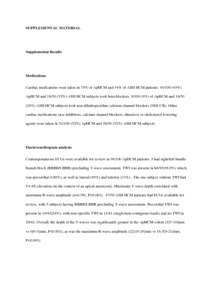Paldino, A; Rossi, M; Dal Ferro, M; Tavcar, I; Behr, E; Sharma, S; Papadakis, M; Sinagra, G; Finocchiaro, G
(2023)
Sport and Exercise in Genotype positive (+) Phenotype negative (-) Individuals. Current Dilemmas and Future Perspectives.
Eur J Prev Cardiol, 30 (9).
pp. 871-883.
ISSN 2047-4881
https://doi.org/10.1093/eurjpc/zwad079
SGUL Authors: Sharma, Sanjay Behr, Elijah Raphael
![[img]](https://openaccess.sgul.ac.uk/115277/1.hassmallThumbnailVersion/circcvim_circcvim-2022-014907_supp1.pdf)  Preview |
|
PDF
Accepted Version
Available under License ["licenses_description_publisher" not defined].
Download (351kB)
| Preview
|
Abstract
Genotype positive - phenotype negative (GEN + PHEN-) individuals harbor a pathogenic or likely pathogenic variant without exhibiting a phenotypic manifestation of the disease. In the last few years, the widespread use of genetic testing in probands and relatives has increasingly led to the identification of these individuals, with emerging dilemmas regarding their clinical management. A genetic variant may exhibit a variable expressivity even in the same family and spontaneous conversion to overt phenotype is largely unpredictable. Little is known about the possible influence of environmental factors, such intense or moderate exercise with open questions regarding their possible role in promoting or worsening the phenotypic expression. Current guidelines for sports participation in this setting acknowledge the weak burden of evidence and the many uncertainties. The recommendations to engage in intensive exercise and competitive sports is usually contingent on annual clinical surveillance, except for pathogenic variants in specific genes, such as LMNA or PKP2. In certain conditions, such as arrhythmogenic cardiomyopathy, guidelines do not differentiate between GEN + PHEN- individuals and patients with overt disease and recommend avoiding participation in high-intensity recreational exercise and competitive sports. It should be emphasized that international guidelines, traditionally restrictive in terms of sports participation and focused on disqualification, embraced recently a more liberal attitude promoting a shared decision-making approach in absence of clinical markers of increased risk. In this review, we will discuss the current state of knowledge on GEN + PHEN- individuals and the dilemmas surrounding the impact of exercise and prognosis, focusing on cardiomyopathies and channelopathies, which are the predominant causes of sudden cardiac death in the young and in young athletes.
| Item Type: |
Article
|
| Additional Information: |
This is a pre-copyedited, author-produced version of an article accepted for publication in European Journal of Preventive Cardiology following peer review. The version of record Alessia Paldino, MD, Maddalena Rossi, MD, Matteo Dal Ferro, MD, Irena Tavcar, MD, Elijah Behr, MA, MBBS, FRCP, Sanjay Sharma, BSc, FRCP, MD, Michael Papadakis, MBBS, MRCP, MD, MRCP, Gianfranco Sinagra, MD, FESC, Gherardo Finocchiaro, MD, PhD, Sport and Exercise in Genotype positive (+) Phenotype negative (-) Individuals. Current Dilemmas and Future Perspectives, European Journal of Preventive Cardiology, 2023;, zwad079 is available online at: https://doi.org/10.1093/eurjpc/zwad079 |
| Keywords: |
cardiomyopathy, channelopathy, genotype positive – phenotype negative, sport |
| SGUL Research Institute / Research Centre: |
Academic Structure > Molecular and Clinical Sciences Research Institute (MCS) |
| Journal or Publication Title: |
Eur J Prev Cardiol |
| ISSN: |
2047-4881 |
| Language: |
eng |
| Dates: |
| Date | Event |
|---|
| July 2023 | Published | | 17 March 2023 | Published Online | | 14 March 2023 | Accepted |
|
| Publisher License: |
Publisher's own licence |
| PubMed ID: |
36929832 |
 |
Go to PubMed abstract |
| URI: |
https://openaccess.sgul.ac.uk/id/eprint/115277 |
| Publisher's version: |
https://doi.org/10.1093/eurjpc/zwad079 |
Statistics
Item downloaded times since 28 Mar 2023.
Actions (login required)
 |
Edit Item |



